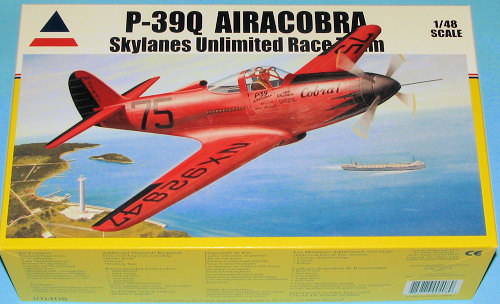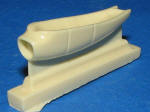
| KIT: | Accurate Miniatures 1/48 P-39Q Airacobra |
| KIT #: | 0408 |
| PRICE: | $22.45 at GreatModels |
| DECALS: | Three options |
| REVIEWER: | Scott Van Aken |
| NOTES: | Reboxed Eduard kit |

| HISTORY |
The story of Bell's P-39 Airacobra is one that has been replayed many times since the end of WWII, most recently with the F-5 and F-20. It is the story of a light fighter; one that is basically designed for short range, local air defense and control. The idea is to build an aircraft that is very fast in initial climb and one that can quickly get to the enemy. It should have enough fire-power to be able to bring down the attacking aircraft and be nimble enough to get the upper hand in combat.
Those were the requirements for the P-39 and those requirements were pretty well met with the prototype. It was fast, has superb climbing ability, and was quite nimble. It also had a short range and as a prototype, was not burdened down with armor and armament. It was also designed for a turbocharged engine to allow it to operate well at high altitudes.
Alas, the Army started messing with it. They wanted to get rid of the troublesome turbo-charging. There goes high altitude performance and some of the speed. It had armament and armor plating added, which also slowed the plane down. It was further burdened with external drop tanks and additional requirements to carry bombs. The result was an aircraft that was still pretty nimble, still pretty fast climbing, but was a total pooch above 15,000 feet, thanks to having a non-turbocharged engine. It was still short ranged thanks to having less than 100 gallons of on-board fuel without external tanks. After all, it was basically a point-defense fighter.
Despite all its shortcomings, there was a war on the way so instead of allowing Bell to build the fighter it wanted (which was the P-63) and stopping production of the P-39, it was continually modified. At low altitudes, it was a superb aircraft, unfortunately most combat took place where the Airacobra was at a distinct disadvantage. However, with the 37mm nose cannon, it was an excellent ground attack plane. Of the nearly 10,000 built during the war, half of that went to the Soviets who liked the heavy armament and used the aircraft as a low level fighter with much success. Post war, many P-36 and P-63 aircraft were used as air racers, some of them being quite successful.
| THE KIT |
There has been much commentary on this kit since its release. Time to take a good look at what you do and don't get in this one. Without going into a lot of detail over the base kit, it is fair to say that when Eduard brought this one out several years ago, it was a real step forward for them. Many consider this to be one of the kits that brought Eduard out of the realm of short run and into the mainstream. The kit is superbly detailed and while it isn't Tamiya or Hasegawa quality, it is still very good.
You can read several full build reviews of this kit here in MM under the rather large 'P' section of the Kit Review Archives. A look at what comes in the box is also on the site.
In a box that is about twice the thickness that it
needs to be, you do get the Eduard kit with the canopy and wheel masks. You do
not get the nose weight, something that you'll need as the P-39 sits tail low
normally. Pack the nose on this one to keep it from tail
 sitting.
You also get a resin lower belly scoop for the two racer versions. The quality
of this molding isn't quite up to the kit itself as the panel lines in the scoop
are larger and not as crisp as what you get with the injected plastic kit. You
might want to consider filling in the scoop panel lines with super glue and
rescribing. Should be easy to do. I also note from the decal and painting
drawing that the scoops shown are not the same depth on both racers nor are they
the exact shame shape as the resin one provided. The one for #75 is shown as
shallower. I've learned to take drawings with a grain of salt, so to speak and
in absence of any photos, will do so.
sitting.
You also get a resin lower belly scoop for the two racer versions. The quality
of this molding isn't quite up to the kit itself as the panel lines in the scoop
are larger and not as crisp as what you get with the injected plastic kit. You
might want to consider filling in the scoop panel lines with super glue and
rescribing. Should be easy to do. I also note from the decal and painting
drawing that the scoops shown are not the same depth on both racers nor are they
the exact shame shape as the resin one provided. The one for #75 is shown as
shallower. I've learned to take drawings with a grain of salt, so to speak and
in absence of any photos, will do so.
The kit also does not come with a 'civilianized' cockpit. Now to be frank, I'm not really sure what the cockpit of these racers looked like. I'd think that they'd have replaced the military one with all the unnecessary bits with a custom panel, but I could well be wrong in this regard. For sure all the heavy an unneeded military gear like armor plating and military radios and the such would be removed. This would include bomb release and gun panels and anything else not absolutely required for racing.
There is also no dedicated 'racer' prop and spinner. I seem to recall that the spinners on these planes were bullet shaped with a pitot tube sticking out of the center of them.
The instructions are designed for use with both the
P-39 kits that AM is doing. On the inside page is a nice run-down of the exhaust
differences for the different variants of the P-39, as the kit gives you
everything for all. There is also a page that tells you what part number props
to use with what versions. There are a set of longer prop blades for use with
the racers, though some have said
that these are not the right props. I don't know. The rest of the instructions
look like what was provided in the Eduard kit aside from written construction
steps on each of the pages. The sheet is the usual for AM with the staples at
the top of the long side of the page. Each step gets its own page, resulting in
a lot of space for notes in some steps. Color information is provided along the
way and referenced to a bunch of different paint makers and FS 595.
have said
that these are not the right props. I don't know. The rest of the instructions
look like what was provided in the Eduard kit aside from written construction
steps on each of the pages. The sheet is the usual for AM with the staples at
the top of the long side of the page. Each step gets its own page, resulting in
a lot of space for notes in some steps. Color information is provided along the
way and referenced to a bunch of different paint makers and FS 595.
A large decal sheet accompanies the kit with all the serials and special markings for the two racers. There is also a standard P-39Q; Bud Anderson's original 'Old Crow'. The decals are nicely printed by Cartograf. To my eyes, the red surround to the national insignia is too anemic. If you think so as well, you may wish to find alternates. The military option is also the subject of at least one aftermarket sheet, should you wish to use that.
A very nicely done full color painting and markings guide is provided, including both top and bottom views in addition to both side profiles. For the racers, you'll have to break out the masking tape as the complex nose 'flames' and the anti-glare panel are not part of the decal sheet.
| CONCLUSIONS |
If you are looking to build the racer versions from the box, you can't. At least and not be totally accurate. While AM was nice enough to provide the lower scoop (which is good for at least the #84 plane), the lack of a proper prop/spinner means you may have to go elsewhere for some form of aftermarket. I've also been told that the racers had a larger dorsal intake. For the cheap amongst us, you can use epoxy putty to make a larger dorsal intake and to put a point on the kit spinner.
As I have no reference photos of the lower scoop on both planes nor the props used nor the interior (google failed me big time), I have no recommendations to offer for that. Perhaps a reader will have the needed info.
Should you wish to build a standard P-39 of any military variant, you can do so with what is included and have a very nice model for under $25.
December 2006
You can get this and other fine kits and accessories at GreatModels
If you would like your product reviewed fairly and quickly by a site that has over 325,000 visitors a month, please contact me or see other details in the Note to Contributors.